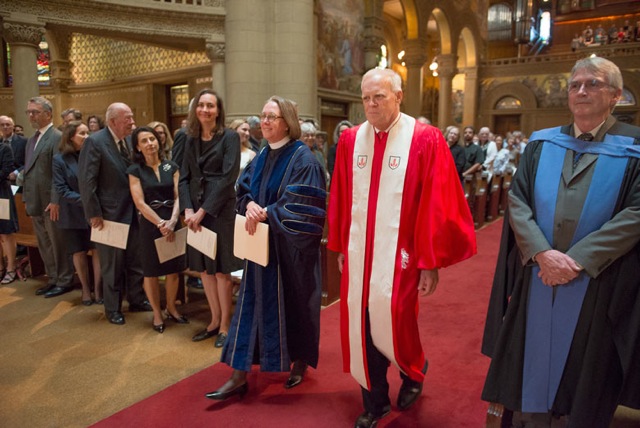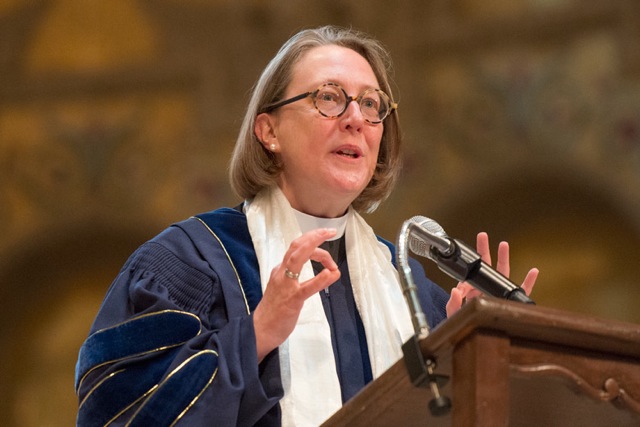
The Rev. Jane Shaw and President John Hennessy entering Memorial Church for the investiture. (Image credit: L.A. Cicero)
Jane Shaw, dean for religious life, officially became the university’s spiritual and ethical leader. Stanford President John Hennessy installed her as dean on Wednesday during a service at Memorial Church with a sermon by guest preacher Anna Deavere Smith, noted actress, playwright and scholar.
Smith spoke of hope, “radical hospitality” and kindness in a sermon that touched on recent events in her hometown, Baltimore, which she visited recently. She was struck by how the vibrant neighborhood of her youth had become what she characterized as a “city of dry bones.”
In her signature style of channeling real-life characters, Smith offered words of hope from Michael Tubbs, who graduated from Stanford in 2012 and that same year became the youngest person in the history of Stockton, California, to be elected to the city council.
Tubb’s message, as Smith conveyed it, was that despite the daunting problems in the city, he was inspired by a level of hope among the young people there. It is a similar message, she said, offered by Quaker writer Parker Palmer, whose words were offered as one of the ceremony’s opening readings.
“Tubbs is asking us to do something that Parker Palmer’s words asked us to do: to let the stranger and the thing we define as strange be who and what they are, allowing them to open us to the vexing and enlivening mysteries we find within and around us. Whether our ultimate reality is God or reason, fear constantly tempts us to try to tame it and contain it within the boundaries of our comfort zones.” Instead, Smith said, it is incumbent upon us to do the hard work of healing even when the path is not clear and to breathe life into those cities of dry bones.
Finally, Smith also told the story of a young girl who, while growing up in Great Britain, had learned a life lesson when witnessing the way her parents treated an elderly neighbor who came to her family home and screamed at her father with startling anger. The young girl’s lasting memory was that her father was completely calm, grounded and kind as he and the girl’s mother calmed the woman down and escorted her home.
“You weren’t afraid of dealing with people who were other than you,” Smith quoted the young girl as saying.

The Rev. Jane Shaw speaking to the audience after her investiture as dean of religious life. (Image credit: L.A. Cicero)
The girl in that story was Jane Shaw, Smith said – “the very person to whom Stanford extends its radical welcome today.”
Educated at Oxford University, where she earned a bachelor’s degree in 1985 and a master’s degree in 1991 and where she also taught history for 16 years, Shaw earned a divinity degree from Harvard University in 1988 and a doctoral degree from the University of California, Berkeley, in 1994. Shaw is a historian, Anglican priest and now professor in the Religious Studies Department at Stanford. She was the dean of Grace Cathedral in San Francisco prior to her appointment at Stanford last September. Her academic gown was Berkeley blue, but she assured the investiture attendees that her suit underneath was Stanford cardinal.
Hennessy praised Shaw’s wide-ranging interests in the arts and sustainability and encouraged her to define her role at Stanford broadly. He charged her to provide ethical guidance, nurture the spiritual lives of all members of the community and help heal the university when it is hurt. Hennessy honored Shaw with a white Tibetan khata scarf that His Holiness the 14th Dalai Lama had presented to him during one of his visits to Stanford.
“We are very fortunate to have her as dean for religious life at Stanford,” Hennessy said. “Under her leadership, I believe our students, staff, faculty and the greater community will benefit from her intelligent guidance.”
In her response, Shaw said: “To be at Stanford at this moment in history is a very particular privilege. Situated in Silicon Valley on the cutting edge of technology and science, and yet equally committed to both the humanities and the arts, Stanford is the place where I have seen and sensed in these last few months since I arrived that really smart, emotionally intelligent and thoughtful people are working to solve the world’s most serious problems. So to be invited to offer spiritual and ethical guidance in that context at this moment in history is truly a privilege.”
Members of the Stanford community who helped to celebrate Shaw’s installation included Robert Huw Morgan, the university organist, who opened the ceremony with Johann Sebastian Bach’s Pièce d’orgue.
Rabbi Patricia Karlin-Neumann, senior associate dean for religious life, and the Rev. Joanne Sanders, associate dean for religious life, offered opening prayers and later joined others in closing prayers from many faith traditions, including Judaism, Christianity, Baha’i, Hinduism, Islam and Buddhism. Father Xavier Lavagetto of the Catholic Community at Stanford welcomed Shaw on behalf of Stanford Associated Religions.
Thomas Steyer, a member of the Stanford Board of Trustees, and Stanford senior and past student body president Elizabeth Woodson provided readings from Ezekiel and Parker Palmer’s Healing the Heart of Democracy.
The St. Lawrence String Quartet performed Franz Joseph Haydn’s Poco Adagio, and the Memorial Church Choir and Stanford Chamber Chorale sang the anthem If You Love Me by Thomas Tallis and Sing Joyfully by Adrian Batten. Professor Paul Harrison, chair of the Department of Religious Studies, welcomed Shaw on behalf of the department. The Bach organ recessional Fantasia sopra ‘Komm, Heiliger Geist, Herre Gott’ closed the ceremony.